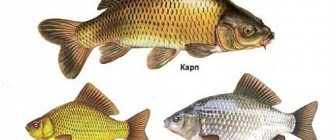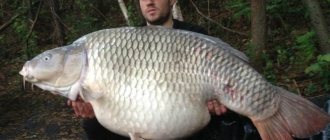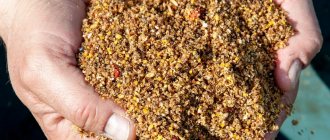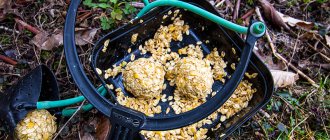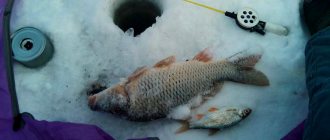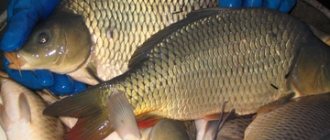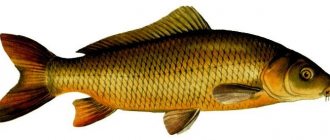— Elongated, sinuous, round body;
Hunting for the carp family is breaking records. Thousands of hundreds of carp and carp are caught in Russia every year. Statistics do not stand still, taking into account trade turnover, to which we should add the forays of tourists and fishing enthusiasts. Why is there such interest in these individuals, what is this connected with?
Initially, I am attracted by the exciting fishing, catching fish, and its taste. These fish have a striking similarity; they are constantly confused by fishermen, cooks and store clerks. How to recognize the difference? With our help, this will be easy to do. So let's look at the two brothers carp and carp and their main differences.
When bringing home a trophy of carp or carp, many fishermen cannot say exactly what kind of fish they caught. They look quite similar, but still there is a significant difference. It’s worth telling in more detail so as not to get into a difficult situation in the future. With such details, you can fall in the eyes of professional fishermen and lower your own rating. Let's look at the criteria between carp and carp, since they are completely different fish.
Carp and carp are caught using various types of gear. Depending on the habitat, fish can be caught using float, bottom or feeder gear. Many professional athletes prefer to catch this type of fish with a spoon.
General description of the carp family
The body of carp and carp is covered with scales from head to tail, but there are subspecies that have very few of them and are located only in the upper part of the body. The color of the fish depends entirely on where they live, and can be light golden or brown.
Carp and carp have an excellent sense of smell, which makes it possible to detect minor vibrations of bloodworms or other larvae in the water even at a ten-meter distance. The upper lip has two pairs of thick whiskers, which are taste receptors.
The fish's head is round and blunt in shape. The mouth is large, retractable, with fragile lips (if you make too sharp a hook during fishing, they will remain on the hook). The mouth cavity contains teeth, thanks to which the fish can chew various plants and small larvae or insects.
The fish matures for reproduction at the age of four years, with males entering this period slightly earlier than females. For spawning, carp choose places that are rich in algae. When the temperature rises to twenty degrees, the fish begins to spawn. A few days after spawning, the eggs become fry.
The fish continues to grow until about a quarter of its life, then growth stops. The largest individuals are a meter long and weigh about 25 kilograms.
Differences
Despite the similarity of fish, they still differ in the following parameters:
- external signs;
- habitat.
Carp is often confused only with common carp, since they are both evenly covered with scales, but you can immediately distinguish it from naked and mirror carp. At the same time, carp have much lighter scales, and the head is not so large.
Unlike carp, carp is more prolific, which is very beneficial for its breeding. In addition, it spreads out in the sides, and the carp increases in length. The difference between them is that carp continues to grow throughout its life, while its domesticated form no longer grows over time. This is due to the fact that the former lives in rivers with strong currents and actively moves to find food.
Carp live at depth and prefer reservoirs with a muddy bottom with little oxygen. Its “ancestor” does not take root well in such water.
Thus, having found out for yourself what is the difference between carp and carp, their habits and where they are found, now you will not confuse them.
What is the difference between carp and carp? The carp always has scales. In carp - not in all individuals. This subspecies is divided into the following varieties...
Places of residence
The habitats of these two types of fish are also different. Carp is not so demanding on the presence of oxygen in a reservoir; 5 mg per liter of water is enough for it; this allows the fish to live and grow well even in small ponds where the water is stagnant. At the same time, carp is much more sensitive to the presence of oxygen - this fish needs at least 8 mg per liter of water, which is why it chooses rivers with strong currents.
Carp is much more heat-loving, unlike carp, and is more common in the southern regions. The optimal temperature for it in the reservoir is 26 degrees Celsius higher, and closer to the southern regions its population is much larger than carp. The latter can live at lower temperatures.
Carp can be easily identified by its habitat; unlike carp, it cannot be found in stagnant bodies of water.
Carp
It is the oldest member of the carp family. It has an elongated (compared to carp) body. Covered evenly with scales (usually golden yellow with black tints). Carp can reach a length of one meter or more.
Carp was bred through hybridization and is a domesticated form of carp. It differs slightly from its ancestor - only in body color and fewer scales.
As a result of long-term selection work, several breeds of carp have been developed. Initially, scaly carp was obtained, differing from carp only in lighter scales. From him it was possible to obtain a breed of mirror carp with large, easily removable scales lying along the sides and back. Subsequently, framed carp were bred with scales arranged in a chain along the ridge, along the lateral line and along the belly, forming something like a frame (hence the name), and naked, with a complete absence of scales.
Tips for fisherman: How to choose a carp rod for long casting - What is the difference, pros and cons
In large reservoirs, carp can be found weighing more than thirty kilograms. They can live more than thirty years. Carp love warmth, which is why there is a large population of wild carp in the southern regions.
In nature there are several forms of carp:
- freshwater;
- marine;
- semi-anadromous, which moves from the seas to the lower reaches of rivers to spawn.
Like other representatives of the cyprinid order, carp does not have a stomach, so it feeds everywhere and always. In winter it goes into a state of hibernation. In the spring, he wakes up and rushes in search of plant food (algae, cattails, reed stems). In autumn, it consumes animal feed. Carps live in reservoirs with silted bottoms and water that does not contain much oxygen, and such places are not very suitable for carp.
To summarize: how to distinguish carp from carp?
Of course, an avid fisherman understands that these are two different fish in character and appearance. But a novice fisherman needs to know clearly: what is the difference between carp and carp, what is the difference? Let's formulate it point by point. Carp is a domesticated carp. Carp is a wild carp. One and the other fish are from the carp family, but carp is a species, and carp is a subspecies.
The carp always has a scaly covering. Not always with carp. The carp is more elongated and grows in length. Carp - wide. The habitat of the carp is flowing reservoirs and rivers. Carps are usually bred in ponds (artificially or naturally). It is characteristic that for normal existence, carp needs less oxygen in the aquatic environment than carp.
Carp is a medium fat fish. Carp meat contains 16 - 19% protein, 3.6% fat, and its calorie content is 90 - 98 kcal per hundred grams of meat. It also contains a complex of macro- and microelements (calcium, phosphorus, potassium, copper, sulfur, iron, cobalt, magnesium, manganese, etc.). And zinc, contained in significant quantities in carp, has antiviral and antitoxic properties.
Zinc is necessary for protein synthesis, it controls muscle contraction, promotes the formation of insulin, helps with atherosclerosis and prostatitis, helps reduce cholesterol deposits, which prevents vascular thrombosis.
The carp has a powerful, moderately long and strong body, which is covered with large dark yellow-golden scales. The scales are edged with a black border, and dark spots are located at the base. Carp does not stop growing in length when it reaches a certain age, unlike carp.
What is the difference between carp and carp?
Carp and carp are close relatives, which are often found in the same body of water, have a similar lifestyle and a very similar appearance. Both are one of the most popular fishing objects for amateur fishermen, since their meat has excellent taste, and the resistance that large specimens provide when fishing makes the fishing process very exciting.
However, for an angler who wants to catch one of these representatives, it is important to know the differences between them and understand the nuances of behavior that are unique to carp or carp
general information
On the upper lip of these fish there are a pair of small whiskers that act as taste buds. Carp and carp are most active in the warm season; in winter they practically do not feed, remaining in wintering pits and not moving around the reservoir.
Types of carp
Selective selection carried out by humans had the goal of breeding from carp such a breed of fish so that it would be more convenient to breed on an industrial scale. Thus the carp was born.
There are the following types of carp:
- Ordinary. This type of carp is most often confused with carp, since their appearance has a lot in common - the entire body of an ordinary (also called scaly) carp is covered with scales, the color of which largely depends on the characteristics of the reservoir in which it lives - from golden to light -brown.
- Mirrored. This species is easily distinguishable from the carp by the absence of scales on most of the body - they are located only on the back, at the gills and caudal fin, as well as along the midline of the body. Mirror carp is found less frequently than common carp, and it is also usually smaller in size.
- Naked. The body of this type of carp has even fewer scales than the mirror carp, which prevents its confusion with carp. It is less common than mirror carp and is also considered the least adapted species to live in environmental conditions close to natural ones.
Types of carp
Depending on the spawning sites, the following types of carp are distinguished:
- Residential. Lives in rivers or in seas where rivers flow into them, where the water is not very salty. Spawns in the same place where it lives.
- Semi-through. This type of carp is distinguished by the fact that during spawning it migrates from seas to rivers.
In order to distinguish these fish, you need to pay attention to the following:
- Body shape. The body of the carp is longer and the body of the carp is wider and thicker.
- Head. In carp it is smaller than in its wild ancestor, and there is also a tubercle at its base.
- Scales. Each scale of the carp has a dark border, whereas its domestic relative has a uniform color.
- Habitat. Carp will live only in running water, so you should not look for it in small ponds with stagnant water, especially when it blooms in the summer, since microscopic algae significantly reduce the oxygen concentration in the water.
Fishing for carp or carp is practically no different - the diet and behavior of these fish are in many ways similar, however, the former is more careful when feeding, it is more frightened by loud sounds, so you need to maintain extreme silence when fishing
Visual camouflage should also not be neglected - camouflage clothing and careful behavior on the shore will significantly increase the chances of a bite
Based on the above, we can highlight the following differences between carp and carp:
- carp is a “cultivated carp”
- In carp, the entire body is covered with scales; in carp, scales may be absent
- carp are longer and narrower, and carp are wider and shorter
- carps love standing reservoirs, and carp love rivers and large lakes with a high oxygen content in the water.
- carps are less shy than carp
Carp was bred by selection from carp: that is, by selecting the best producers, culling individuals that do not meet the requirements, and by inbreeding - parents are crossed with offspring, brothers and sisters, which helps to obtain a larger number of individuals with the desired properties. Carp is the progenitor of carp, and as they say in the proverb: “The apple doesn’t fall far from the tree.”
Biologists' opinion
Science distinguishes carp and carp as two different fish, giving them different names. Latin name of carp: Cyprinus carpio Latin name of carp: Cyprinus carpio carpio From the point of view of biologists, the repetition of the second word (carpio carpio) in the Latin name is not accidental, it sounds like “carp carp” or “carp sazanovich”, “carp’s son”, i.e. . offspring of carp. Carp is a species, and carp is a subspecies of carp: a domesticated form of carp, bred in closed reservoirs and ponds.
- naked - scales are completely absent, this species is not found in wild bodies of water due to low viability;
- mirror - scales in 3-4 rows on the sides of the carcass and near the fins. The most common variety;
- framed - several rows of scales near the anus and along the dorsal fin.
Which is better: carp or carp
Conditions for development affect not only the taste characteristics, but also the usefulness of the fish. The cleaner the reservoir and the more often the water is changed, the more useful the catch will be. Therefore, preference should be given to carp . Carp must either be caught independently in a clean pond without mud and silt, or purchased from trusted suppliers.
The meat of both cyprinids contains:
- vitamins A, B and C;
- thiamine;
- cobalamin;
- large amount of protein.
The safety of these beneficial substances and the taste of the finished fish dish depend on the cooking technology and method of heat treatment.
Carp and carp are two species belonging to the same family. They can be distinguished by appearance, body structure and habitat. From the point of view of taste characteristics, these two fish have practically no differences.
Carp, the most commonly found in Russian reservoirs, can be divided into 3 types based on appearance:
Learning to distinguish carp/carp from crucian carp
Sometimes novice fishermen confuse two types of carp fish - carp and crucian carp , often not only in appearance , but also assuming that they have exactly the same habits and lifestyle . However, each species has its own behavioral characteristics , which, accordingly, is reflected in fishing tactics .
What does carp look like?
The carp's body grows wider.
Tips for fisherman: Which boilies are best for carp in summer - All the nuances
Carp, the most commonly found in Russian reservoirs, can be divided into 3 types based on appearance:
Common carp (scaly)
This fish is evenly covered with dense scales, the color of which can vary from brown to golden in different habitats.
The scaly carp reaches the largest size among its fellows.
Mirror carp
It is very different from ordinary carp. Its body is almost naked, with sparse large scales. It can be located along the lateral line or in islands, leaving most of the body unprotected. Large individuals may have a large belly due to the lack of hard scales. They are less common than scaly carp and reach smaller sizes.
Naked leather carp
Very rare. The body is practically naked. Rare scales may be located near the tail and gills. The smallest and most unadapted to life among carps.
As for the carp, it is a distant relative of the previous specimen. If you don’t look closely, they can be quite easily confused, however, the former are domesticated breeds, and the latter are wild . On the body of any carp there is a scaly layer, and it can only grow in length, but not in width, unlike carp .
What does carp look like and where to look for it?
As for the carp, it is a distant relative of the previous specimen. If you don’t look closely, they can be quite easily confused, however, the former are domesticated breeds, and the latter are wild . On the body of any carp there is a scaly layer, and it can only grow in length, but not in width, unlike carp .
You should look for carp in water bodies famous for fast flows and high oxygen concentrations . In this case, it is more effective to use running tackle, which is characterized by high strength. Or try fishing with a donk. You might be interested in learning about catching pike perch on a donka.
Based on the above, we can highlight the following differences between carp and carp:
- carp is a “domesticated carp”;
- scales are always observed in carp, while scales may be absent in carp;
- carp are longer and carps are wider;
- carps love stagnant water, and carp love fast currents;
- these two species are cyprinids, and carp are considered a subspecies of carp.
We hope that now you can distinguish carp from carp.
Carp loves fast rivers with a high oxygen content in the water. At least 6-7 mg/l. Therefore, for normal life and growth, carp needs running water.
Carp
Common carp is the wild ancestor of the carp. It also belongs to the carp family. In many ways it is similar to its domesticated relative, at least in body structure. The color of the scales is also golden. The body of carp is always covered with scales. Due to the fact that the carp lives mainly in rivers, it grows in length and not in thickness.
Carp
If for the carp, in its habitat, already in the second year of life there are no natural enemies or competitors in the kingdom of fish, and it can rightfully be considered the owner of the reservoir, then the carp in its wild habitat is forced to defend itself from natural enemies. Even when reaching large sizes, carp can become prey for larger fish, for example: voracious catfish. Carp is not only a cautious fish, but also very timid. Therefore, carp, unlike carp, is not easy to find.
Differences in behavior and habits
The carp primarily lives in its natural environment, this is reflected in its behavior. The fish is much more careful, unlike the carp, since it has many enemies in the rivers, while the second does not need to hide from predators for the entire first year of life. That is, when fishing for carp, it is necessary to more carefully observe the silence regime and choose the right camouflage.
The daily diet of these fish is also slightly different - carp in the spring often feeds on the eggs of other fish species, and in some cases, if there is very little food in the reservoir, it does not disdain even fry. At the same time, carp prefer to feed on vegetation, this is due to artificial feeding in the ponds where this fish is grown.
During selection, carp acquired such a distinctive feature as increased fertility, while carp have much fewer eggs during the spawning period, and they are much more demanding of spawning conditions.
Differences in external features
In terms of internal and external characteristics, carp and its cultural form, carp, are the same fish, but some differences still exist.
Carp
The carp has a powerful, moderately long and strong body, which is covered with large dark yellow-golden scales. The scales are edged with a black border, and dark spots are located at the base. Carp does not stop growing in length when it reaches a certain age, unlike carp.
Carp has large, pale yellow scales, and a more rounded body. Some types of carp may not have scales at all or have them in small quantities. Upon reaching a certain age, carp stop growing and only continue to gain weight.
And the difference in body shape is not surprising. The majority of carp live in rivers, lead a wild lifestyle, and are forced to move a lot in search of food. Therefore, his body is longer, leaner and more muscular. Carp artificially grown in reservoirs do not need to move much: there is no or weak current, they are usually fed enough so that it grows quickly. Therefore, his body is rounder and thicker.
Selection was carried out over 31 years, it ended in 1994, and the resulting breed was approved. The selection was carried out on the basis of several characteristics. Only the best mirror carp were crossed with each other; no other breeds were used.
Breeding carp under controlled conditions is commonly called carp farming. The first attempts to obtain new forms from wild carp were made in China. Carp farming also developed completely independently in Europe, where domestic carp were obtained from the Danube carp. It was chosen because it has tasty meat and grows well and adapts to life in a pond. Another breed of wild carp is the ornamental koi carp, bred in Japan.
Tips for fisherman: What hooks are needed for catching carp - Detailed review
Mirror carp was obtained by selective selection in Germany, so it has another name - “German”. It is also known as king carp. It is not possible to clarify the exact time of the appearance of the first mirror carp. There is believed to be reliable information about "German" carp, which were first introduced to England in 1860.
Why is it called mirror or royal?
The mirror carp has very original large scales in the form of plates, reminiscent of mirrors, which gave the name to this breed. These unusual scales do not cover the entire body of the fish, but are located along the ridge, on the sides and in the tail. The largest scales are located behind the gill covers.
Later it was found that the number of scales and their size depend on the combination of two pairs of genes, and this fact began to be used in carp breeding.
Appearance Features
The mirror carp is very easy to distinguish from all other fish that are included in the order Cypriniformes. This can be done thanks to the special arrangement of the scales, as mentioned above:
- only certain parts of its body are covered with scales;
- the sides of the body are almost bare;
- the scales are very large, plate-like, and have a beautiful shiny golden or silver color.
The color of this carp in different reservoirs may be different. The dark dorsal part of the body is black or deep dark green. In the abdominal area the body is lighter: golden or dark yellow. The color of the fins is brownish or yellowish. The body of the king carp is tall with a small hump behind the head in the dorsal area. His head is big. But the shape of the lips and 4 whiskers are the same as those of all carp and carp.
Size
As a result of selection, the mirror carp has acquired and inherited genetic characteristics that give it the opportunity to be the largest among all carp. Sometimes they reach very impressive sizes.
The record size of a specimen caught in Hungary is known to be 125 centimeters. This fish was caught in 2015 and weighed more than 47 kilograms.
But in general, this subspecies of carp is much smaller. Typically, specimens are obtained whose weight is from 500 grams and no more than 20 kilograms. The body length is from 30 centimeters to 1 meter.
Carp farming in Europe
In Europe, carp fish were grown in specially built ponds in the Czech Republic back in the 13th century. This turned out to be profitable and became an impetus for the rapid development of carp farming. After three hundred years (in the middle of the 16th century), a book on fish farming was written in this country by the famous fish farmer of those times, Jan Dubrava, which mentioned carp. By this time, carp began to be bred in England and later in the countries of the Scandinavian Peninsula.
Practicing fish farmers paid attention to the growth rate of carp and selected the fastest growing individuals. Its cultivated form (carp) differs from the original species (carp) in that its body is taller. This feature is associated with the greater meatiness of carp compared to carp. Therefore, selection work to improve carp breeds is aimed at increasing body height and dorsal thickness.
Advantages of mirror carp and its cold-resistant breed - Altai
The freshwater fish Altai mirror carp was created thanks to the directed selection work of Z. A. Ivanova and her colleagues.
Selection was carried out over 31 years, it ended in 1994, and the resulting breed was approved. The selection was carried out on the basis of several characteristics. Only the best mirror carp were crossed with each other; no other breeds were used.
Two important features of the Altai mirror carp:
- adaptability to survival in cold conditions;
- stable inheritance of traits important for quickly obtaining a food product.
This breed of carp is distinguished by its early maturity: rapid growth with low feed costs; high fertility; high yield of fillet mass.
